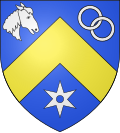Angecourt: Difference between revisions
GreenC bot (talk | contribs) m 1 archive template merged to {{webarchive}} (WAM) |
|||
| Line 27: | Line 27: | ||
The inhabitants of the commune are known as ''Dadas''<ref>[http://www.habitants.fr/habitants_departement_ardennes_08.html Inhabitants of Ardennes] {{Fr}}</ref> |
The inhabitants of the commune are known as ''Dadas''<ref>[http://www.habitants.fr/habitants_departement_ardennes_08.html Inhabitants of Ardennes] {{Fr}}</ref> |
||
The commune has been awarded '''one flower''' by the ''National Council of Towns and Villages in Bloom'' in the ''Competition of cities and villages in Bloom''.<ref>[http://www.cnvvf.fr/les_villes_et_village_fleuris-47.html Angecourt in the Competition for Towns and Villages in Bloom] {{ |
The commune has been awarded '''one flower''' by the ''National Council of Towns and Villages in Bloom'' in the ''Competition of cities and villages in Bloom''.<ref>[http://www.cnvvf.fr/les_villes_et_village_fleuris-47.html Angecourt in the Competition for Towns and Villages in Bloom] {{webarchive |url=https://web.archive.org/web/20141210053901/http://www.cnvvf.fr/les_villes_et_village_fleuris-47.html |date=December 10, 2014 }} {{Fr icon}}</ref> |
||
==Geography== |
==Geography== |
||
Revision as of 17:35, 13 November 2016
Angecourt | |
|---|---|
Angecourt village | |
| Country | France |
| Region | Grand Est |
| Department | Ardennes |
| Arrondissement | Sedan |
| Canton | Raucourt-et-Flaba |
| Intercommunality | Trois Cantons |
| Government | |
| • Mayor (2008–2020) | Jean-Claude Philippe |
| Area 1 | 3.73 km2 (1.44 sq mi) |
| Population (2009) | 352 |
| • Density | 94/km2 (240/sq mi) |
| Time zone | UTC+01:00 (CET) |
| • Summer (DST) | UTC+02:00 (CEST) |
| INSEE/Postal code | 08013 /08450 |
| Elevation | 161–307 m (528–1,007 ft) (avg. 270 m or 890 ft) |
| 1 French Land Register data, which excludes lakes, ponds, glaciers > 1 km2 (0.386 sq mi or 247 acres) and river estuaries. | |
Angecourt is a French commune in the Ardennes department in the Grand Est region of northern France.
The inhabitants of the commune are known as Dadas[1]
The commune has been awarded one flower by the National Council of Towns and Villages in Bloom in the Competition of cities and villages in Bloom.[2]
Geography
Angecourt is located some 8 km south-east of Sedan and 7 km north-west of Mouzon. Access to the commune is by road D6 from Remilly-Aillicourt in the north-east which passes through the commune and the village and continues to Haraucourt in the south-west. About half of the commune in the south and east is forested with the rest farmland.[3]
The Ennemane flows through the commune from south-west to north-east to join the Coupure de Remilly at Remilly-Aillicourt.
Neighbouring communes and villages
History
- From 1560 to 1642 Angecourt was part of the Principality of Sedan.
- Battle of Sedan (1940)
Heraldry
Administration
List of Successive Mayors[4]
| From | To | Name | Party | Position |
|---|---|---|---|---|
| 2001 | 2020 | Jean-Claude Philippe |
(Not all data is known)
Demography
In 2009 the commune had 352 inhabitants. The evolution of the number of inhabitants is known through the population censuses conducted in the commune since 1793. From the 21st century, a census of communes with fewer than 10,000 inhabitants is held every five years, unlike larger towns that have a sample survey every year.[Note 1]
Template:Table Population Town

Culture and heritage
Civil heritage
A Spinning Mill at 15 Rue du Chateau (19th century)![]() is registered as an historical monument.[5]
is registered as an historical monument.[5]
Religious heritage
- The Church of Saint Médard contains a Funeral Plaque of Nicolas des Oudet (18th century)
 which is registered as an historical object.[6]
which is registered as an historical object.[6]
See also
Notes
- ^ At the beginning of the 21st century, the methods of identification have been modified by law No. 2002-276 of 27 February 2002 [1], the so-called "law of local democracy" and in particular Title V "census operations" which allow, after a transitional period running from 2004 to 2008, the annual publication of the legal population of the different French administrative districts. For communes with a population greater than 10,000 inhabitants, a sample survey is conducted annually, the entire territory of these communes is taken into account at the end of the period of five years. The first "legal population" after 1999 under this new law came into force on 1 January 2009 and was based on the census of 2006.
References
- ^ Inhabitants of Ardennes Template:Fr
- ^ Angecourt in the Competition for Towns and Villages in Bloom Archived December 10, 2014, at the Wayback Machine Template:Fr icon
- ^ Google Maps
- ^ List of Mayors of France
- ^ Ministry of Culture, Mérimée IA08000311 Spinning Mill Template:Fr icon
- ^ Ministry of Culture, Palissy PM08000023 Funeral Plaque of Nicolas des Oudet Template:Fr icon
External links
- Angecourt on the old IGN website Template:Fr icon
- Angecourt on Lion1906
- Angecourt on the 1750 Cassini Map
- Angecourt on the INSEE website Template:Fr icon
- INSEE Template:Fr icon


